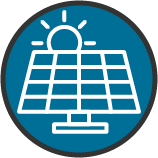| 1 | UTILITY PREPAREDNESS FOR CLIMATE IMPACTS Ensure processes are in place to regularly assess the impacts of climate change on water and energy utilities. | Near Term | |  |
| 2 | RISK ASSESSMENT OF CRITICAL INFRASTRUCTURE
Work with responsible parties to ensure that they identify and undertake critical infrastructure (transportation, building, IT and telecoms, utilities sectors) risk assessments once updated floodplains are available and incorporate additional future climate projections related to temperature and precipitation. | Long Term | | |
| 3 | HEAT RISK ASSESSMENT
Undertake risk assessment for managing the impacts of extreme heat with a focus on low-income, public housing, and City-subsidized residential buildings and identify opportunities to implement UHI reduction measures (as outlined in mitigation strategies) with a focus on vulnerable populations. | Near Term | |  |
| 4 | FLOOD-PROOF ROADWAYS
Once FEMA floodplains are updated using Atlas 1454 rainfall intensity values, undertake a prioritized assessment of flood resilience options for all low-lying roadways. | Near Term | | |
| 5 | PROTECT TRANSIT RIDERS
Work with VIA to assess public transportation routes, stops, and associated infrastructure and identify potential shelter improvements to prepare for extreme weather events. | Near Term | | |
| 6 | BUILDING RETROFITS FOR VULNERABLE POPULATIONS
Prioritize retrofit program assistance for vulnerable populations according to risk level and building type once updated floodplains are available and consider future extreme precipitation levels. Atlas 14 rainfall intensity values were codified in April 2019. FEMA floodplains will be updated between 2020 and 2023. | Near Term | |  |
| 7 | CLIMATE RISK IN DEVELOPMENT REVIEW PROCESS
Develop and pilot a questionnaire in the building development review process to assess how climate change could impact new development and major renovations and provide support to developers to design their buildings to be resilient to climate impacts (SA Tomorrow, GB12). | Near Term | |  |
| 8 | FEMA COMMUNITY RATING SYSTEM
Join FEMA’s Community Rating System (CRS) program (SA Tomorrow, GB13). | Near Term | | |
| 9 | HEALTHY BY DESIGN
Develop a “Healthy by Design” program for all new affordable housing projects (SA Tomorrow, PH8) to incorporate resilient design principles. | Long Term | |  |
| 10 | FLOOD-PROOF CRITICAL INFRASTRUCTURE
Work with responsible parties to identify and undertake prioritized retrofit programs for critical infrastructure (transportation, building, IT and telecoms, utilities sectors) to ensure resilience to flood impacts over the lifetime of the asset, once updated floodplains are available and also incorporating future climate projections. Atlas 14 rainfall intensity values were codified in April 2019. FEMA floodplains will be updated between 2020 and 2023. | Long Term | |  |
| 11 | RESILIENCE IN BUILDING CODES AND PROGRAMS
Assess opportunities to integrate resilience measures (e.g. water and temperature regulation, resilient landscaping measures within Low Impact Development, Build SA Green, Under 1 Roof programs) into building codes, existing building programs and checklists to reduce impacts from projected climate change over the lifetime of developments. | Long Term | |  |
| 12 | PRODUCE A CLIMATE HERITAGE STRATEGIC PLAN
Develop guidelines for determining the appropriate management of cultural sites and objects around climate change adaptation including: building an inventory of resources, developing methods for building adaptive capacity, providing input on climate policies affecting tangible and intangible heritage resources, and joining the Climate Heritage Network. | Near Term | | |




















